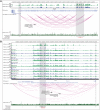In the loop: promoter-enhancer interactions and bioinformatics
- PMID: 26586731
- PMCID: PMC5142009
- DOI: 10.1093/bib/bbv097
In the loop: promoter-enhancer interactions and bioinformatics
Abstract
Enhancer-promoter regulation is a fundamental mechanism underlying differential transcriptional regulation. Spatial chromatin organization brings remote enhancers in contact with target promoters in cis to regulate gene expression. There is considerable evidence for promoter-enhancer interactions (PEIs). In the recent years, genome-wide analyses have identified signatures and mapped novel enhancers; however, being able to precisely identify their target gene(s) requires massive biological and bioinformatics efforts. In this review, we give a short overview of the chromatin landscape and transcriptional regulation. We discuss some key concepts and problems related to chromatin interaction detection technologies, and emerging knowledge from genome-wide chromatin interaction data sets. Then, we critically review different types of bioinformatics analysis methods and tools related to representation and visualization of PEI data, raw data processing and PEI prediction. Lastly, we provide specific examples of how PEIs have been used to elucidate a functional role of non-coding single-nucleotide polymorphisms. The topic is at the forefront of epigenetic research, and by highlighting some future bioinformatics challenges in the field, this review provides a comprehensive background for future PEI studies.
Keywords: CTCF; Chromatin loops; SNPs; chromosome conformation capture; enhancer prediction; histone modifications; promoter–enhancer interactions; transcription factories.
© The Author 2015. Published by Oxford University Press.
Figures



References
-
- Gilbert N, Boyle S, Fiegler H, et al. Chromatin architecture of the human genome: gene-rich domains are enriched in open chromatin fibers. Cell 2004;118(5):555–66. doi: 10.1016/j.cell.2004.08.011. - PubMed
-
- Barski A, Cuddapah S, Cui K, et al. High-resolution profiling of histone methylations in the human genome. Cell 2007;129(4):823–37. doi: 10.1016/j.cell.2007.05.009. - PubMed
Publication types
MeSH terms
Substances
LinkOut - more resources
Full Text Sources
Other Literature Sources

